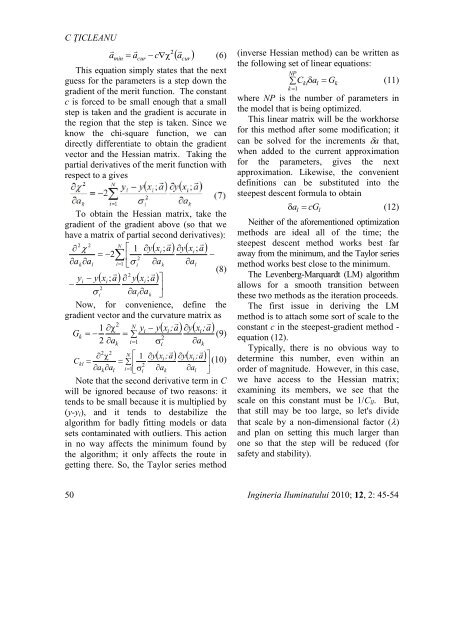ingineria iluminatului - Journal of Lighting Engineering - Prof. Florin ...
ingineria iluminatului - Journal of Lighting Engineering - Prof. Florin ...
ingineria iluminatului - Journal of Lighting Engineering - Prof. Florin ...
Create successful ePaper yourself
Turn your PDF publications into a flip-book with our unique Google optimized e-Paper software.
C ŢICLEANU<br />
<br />
2<br />
amin<br />
acur<br />
c<br />
<br />
(6)<br />
a <br />
cur<br />
This equation simply states that the next<br />
guess for the parameters is a step down the<br />
gradient <strong>of</strong> the merit function. The constant<br />
c is forced to be small enough that a small<br />
step is taken and the gradient is accurate in<br />
the region that the step is taken. Since we<br />
know the chi-square function, we can<br />
directly differentiate to obtain the gradient<br />
vector and the Hessian matrix. Taking the<br />
partial derivatives <strong>of</strong> the merit function with<br />
respect to a gives<br />
To obtain the Hessian matrix, take the<br />
gradient <strong>of</strong> the gradient above (so that we<br />
have a matrix <strong>of</strong> partial second derivatives):<br />
2 2<br />
N <br />
1 yxi<br />
; a<br />
yxi<br />
; a<br />
2<br />
<br />
<br />
2<br />
ak<br />
al<br />
i1 <br />
i ak<br />
al<br />
<br />
(8)<br />
2<br />
y i y xi<br />
; a y xi<br />
; a<br />
2<br />
<br />
a<br />
a<br />
i<br />
l<br />
Now, for convenience, define the<br />
gradient vector and the curvature matrix as<br />
2<br />
<br />
1 <br />
N yi<br />
yxi<br />
; a<br />
yxi<br />
; a<br />
Gk<br />
<br />
(9)<br />
2<br />
2 ak<br />
i1 i<br />
ak<br />
2 2<br />
<br />
N 1 yx<br />
<br />
i ; a y xi<br />
; a<br />
Ckl<br />
<br />
(10)<br />
2<br />
akal<br />
i1 i<br />
ak<br />
al<br />
<br />
Note that the second derivative term in C<br />
will be ignored because <strong>of</strong> two reasons: it<br />
tends to be small because it is multiplied by<br />
(y-yi), and it tends to destabilize the<br />
algorithm for badly fitting models or data<br />
sets contaminated with outliers. This action<br />
in no way affects the minimum found by<br />
the algorithm; it only affects the route in<br />
getting there. So, the Taylor series method<br />
k<br />
(inverse Hessian method) can be written as<br />
the following set <strong>of</strong> linear equations:<br />
50 Ingineria Iluminatului 2010; 12, 2: 45-54<br />
NP<br />
C a<br />
G<br />
k 1<br />
kl<br />
l<br />
k<br />
(11)<br />
where NP is the number <strong>of</strong> parameters in<br />
the model that is being optimized.<br />
This linear matrix will be the workhorse<br />
for this method after some modification; it<br />
can be solved for the increments a that,<br />
when added to the current approximation<br />
for the parameters, gives the next<br />
approximation. Likewise, the convenient<br />
definitions can be substituted into the<br />
steepest descent formula to obtain<br />
a cG<br />
(12)<br />
l<br />
Neither <strong>of</strong> the aforementioned optimization<br />
methods are ideal all <strong>of</strong> the time; the<br />
steepest descent method works best far<br />
away from the minimum, and the Taylor series<br />
method works best close to the minimum.<br />
The Levenberg-Marquardt (LM) algorithm<br />
allows for a smooth transition between<br />
these two methods as the iteration proceeds.<br />
The first issue in deriving the LM<br />
method is to attach some sort <strong>of</strong> scale to the<br />
constant c in the steepest-gradient method -<br />
equation (12).<br />
Typically, there is no obvious way to<br />
determine this number, even within an<br />
order <strong>of</strong> magnitude. However, in this case,<br />
we have access to the Hessian matrix;<br />
examining its members, we see that the<br />
scale on this constant must be 1/Cll. But,<br />
that still may be too large, so let's divide<br />
that scale by a non-dimensional factor ()<br />
and plan on setting this much larger than<br />
one so that the step will be reduced (for<br />
safety and stability).<br />
l
















